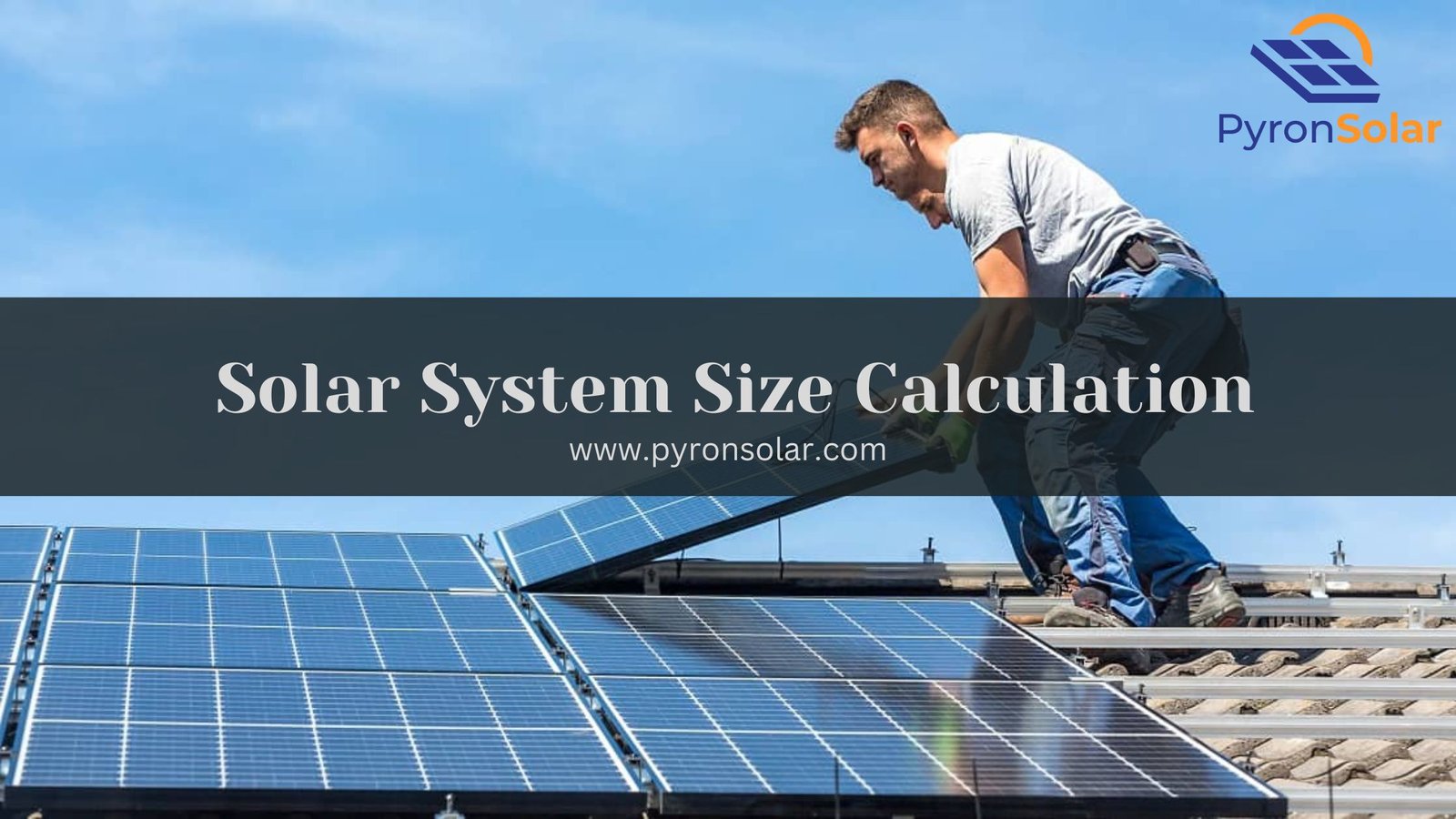For homes, purchasing a solar system is a wise decision. The most recent photovoltaic (PV) systems, including solar panels, were long-lasting, simple to use, that offer energy savings. If you want to get the most out of it, you would like to know how to size better your grid-tie solar System that covers your energy demand patterns while oversizing your PV system.
To get the most out of your solar project, follow these instructions to discover how to analyze your solar demands, get a sizing estimation, and pick the appropriate panels.
Sizing a Solar System
Follow these guidelines for what size of solar System your need so that you can determine the exact amount that will meet your energy requirements if you want to do something other than the math and would prefer a quick estimation.
Calculate Solar System Size On Your Monthly Average kWh Use
Whenever the A/C or heat is on, most individuals use more electricity in the summer and winter. If you can, gather your last 12 electric bill statements. Then, divide your kWh consumption by 12 to obtain a monthly total.
Calculate the kWh You Use Each Day
Then, multiply your monthly kWh consumption by 30 to determine your average daily kWh consumption. The typical American household consumes 900 kWh per month.
Take into Account Inefficiencies
The deterioration rate of solar panels is computed as 20% divided by 25 years or a reduction in output of 0.8% each year if the performance warranty for your solar panels guarantees 80% efficiency after 25 years. A panel rated for 400 watts may only produce 320 watts at the end of its lifespan.
Offset, Full or Partial
Most grid-tied homes opt to offset their energy demands with solar power completely. However, to begin with, it is also feasible to use a more modest system for partial offset and then scale it up later as needed to fit the budget. You can take partial compensation into account here if that’s your aim.
As an illustration, suppose you would like to begin by using solar energy to offset half of the energy consumption: 3.6 kW solar array obtained by multiplying 7.2 kW by 0.5.
Determine how many solar panels or how many watt you’ll need. To get the required number of solar panels, split the final array size even by the needed solar panels’ power.
I use a 7.2 kW (7,200-watt) array to illustrate 100% offset.
What Kind of Solar Electricity Will You Require?
Examine previous utility bills to figure out your home’s typical energy use. You could determine the number of solar panels you require by calculating the hourly energy needs of your household by the peak sunlight hours in your region, then dividing the result by the panel’s wattage.
Generate a range by using examples of low-wattage (150 W) or high-wattage (370 W) systems (for instance, 17–42 panels to produce 11,000 kWh annually). Remember that there are additional factors, such as the size and exposure of your roof to sunlight.
What Impact Does the Size Of a Solar Panel Have?
Solar panel size and quantity are crucial factors to consider if your roof is small or has an odd shape. If you have much available roof space, you can forgo some efficiency and get larger panels (at a cheaper cost per panel) to reach your desired energy output.
However, the best approach to generate the most power over the long run and eventually save you the most money may be to utilize fewer smaller, high-efficiency panels if the usable roof surface is constrained or partially shadowed.
Solar Panel Dimensions
Home solar panels are typically 5.4 feet by 3.25 feet, or 65 inches by 39 inches, with some manufacturer variance. A SunPower panel is 61.3 by 41.2 inches in dimension.
Although these measurements have not changed over time, the efficiency or output from the same footprint has dramatically increased. SunPower also builds whole systems with almost no gaps among panels and uses invisible framing and mounting gear to keep the rooftop footprint as small, practical, and appealing as feasible.
Calculate Off-Grid Solar System
By determining the wattage ratings of your appliances and the number of hours a day you plan to run them, you can decide on your daily power usage in Watt-hours. For instance, if I use a single 50 Watt fan running for three hours daily, it will produce 150 Wh (50W x 3 hrs = 150 Wh) daily.
The Price Per Square Foot Of Solar Panels
I would say that calculating the cost per square foot of solar panels can take time and effort. This is so that the price of the panels might vary depending on several parameters like best tilt angle of solar panel , including size, kind, and quality. Therefore, it might determine the cost per square foot difficulty. The information is included in the prices below:
- Installation
- Additional equipment
- Warranty
- Certificate
- Panels
Here are some examples of systems and the approximate cost you should aim for solar panel size per kilowatt.
2KW System
This will cover 150 square feet. Considering a mid-range system, the typical price would be £2,775. This implies that you’ll pay about £18.50 per square foot for the System.
3KW System
This will cover 225 square feet. It is calculated at £22,12 per square foot. Again considering a mid-range system, the typical price for this could be close to £5,000.
4KW System
This would cover 301 square feet. If we pick a different kid-range system, the installation will run about £7,000. The price per square foot would be £23.26 as a result.
How Many Panels?
Quality can genuinely make a difference because there are significant differences in solar panels’ capacities and performance levels. PV solar panels typically range in power from 150 watts to 345 watts per panel, based on their size and the cell technology used for each module.
Divide your home’s hourly energy usage by the solar panels’ power to determine solar system calculation for the home. Doing so will enable you to create a range of sizes and provide you with realistic ideas. It would help if you did it for both low and high-wattage options.
This estimates the number of solar panels you’ll need to produce energy for your home. A professional installer will next visit and assess your roof to determine the optimal angle and how you should install the panels there.
Frequently Asked Questions:-
- Explain solar power sizing?
Take your daily kWh energy requirement and divide it by your peak sun hours to have the kW output to size your solar system. To determine the approximate number of solar panels you’ll need for your System, split the kW output by the performance of your panels.
- Explain solar cell sizing?
Solar cells, typically 6-by-6-inch squares, make up every solar panel. Solar panels usually include 60 cells for domestic and 72 for commercial use. Based on the number of cells, two fundamental types of solar panels are easily accessible.
- Is a 5kw solar system size sufficient for a house?
A modest to medium-sized house can quickly get all the electricity it needs daily using a 5kW off-grid solar system.
- How to do PV solar calculations?
Generally speaking, the output of a photovoltaic system is estimated using the formula E = A x r x H x PR. For instance, a 250 Wp PV module with a 1.6 m2 area has a 15.6% solar panel yield.
- How to Build an Off-Grid Solar System?
By determining the wattage ratings of your appliances and how many hours a day you plan to run them, you can evaluate your daily power usage in Watt-hours. For instance, my single 50 Watt fan running for three hours daily will produce 150 Wh (50W x 3 hours = 150 Wh) per day.
- What size is the solar System 6.6 kW?
Usually, between 20 and 24 solar panels make up a 6.6kW installation. The panels’ efficiency will determine how many are needed for a 6.6kW installation.
- How should a photovoltaic solar system be sized?
Take your daily kWh energy requirement and divide it by your peak sun hours to get the kW output to size your solar system. To determine the approximate number of solar panels you’ll need for your System, split the kW output by the efficiency of your panels.
- The solar 120% rule is what?
Solar PV systems should be put in electrical boxes up to 120% of the busbar’s label rating, according to the NEC’s 120% rule. The rule permits an additional 20%, or 35 amps, from the solar system if the home’s electrical meter capacity is 175 amps.
- How can I determine the size of the solar system I require?
It can determine the number of solar panels you require by calculating the hourly energy needs of your household by the peak sunlight hours in your region, then dividing the result by the panel’s wattage.
Create a range by using examples of low-wattage (150 W) and high-wattage (370 W) systems (for instance, 17–42 panels to produce 11,000 kWh annually).
- Can you restore a certain amount of kW to the grid?
PV capacity, as well as production, are not equivalent or necessarily related. There is a cap on the maximum quantity of output that can be connected to the DNO (grid) without prior authorization. The 3.68kW per phase cap (before an authorization is necessary) applies to the inverter’s AC output, not just the solar panel system’s CAPACITY.
Conclusion
Before determining a solar system’s capacity, its calculation must come first. In this blog, I have talked about the size of the main off-grid system components, such as solar panels, solar inverters, and solar batteries.
To determine the size of a solar system, it is important to first determine the energy requirements in terms of kWh (kilowatt-hour) usage units. Once the system capacity has been determined, it will determine all component sizes.
Having said most of it, I’ll conclude by stating that there are numerous ways available to calculate solar system size as well.
Ray is an avid reader and writer with over 25 years of experience serving various domestic and multinational private and public energy companies in the USA.



